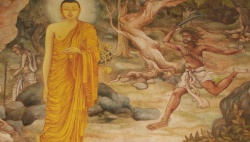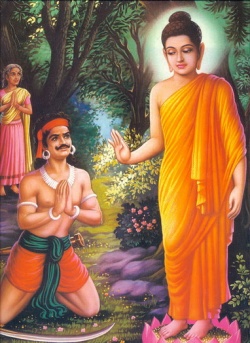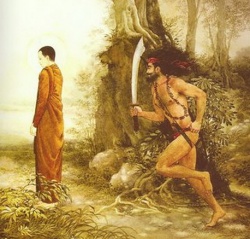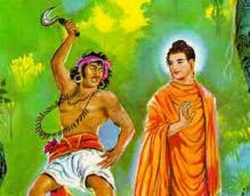Angulimala
Angulimala
央掘摩羅 (Pali; Skt Angulimalya; Jpn Okutsumara)
A follower of Shakyamuni in Shravasti, India. In Buddhist scriptures, he is often referred to as an example of the conversion of a heinous man to Buddhism. Angulimala means necklace of fingers, a name said to derive from a necklace he wore made of the severed fingers of those he had murdered. According to the Sutra on the Wise and the Foolish, he originally
studied under a teacher of Brahmanism in Shravasti. When Angulimala spurned the advances of his teacher's wife, she was angered and slandered him to her husband, saying that he had made advances to her. Enraged, the teacher told Angulimala falsely that, if he killed a thousand people (a hundred according to another account) and cut off one finger from each of them, he could be reborn
in the Brahma Heaven. Obeying his teacher, he killed and continued to kill. When he was about to kill his mother to make his thousandth victim, he met Shakyamuni Buddha. He tried to kill Shakyamuni, but was instead instructed and converted by the Buddha. Repenting of his evil deeds, he devoted himself to Buddhist practice. According to the Increasing by One Agama Sutra,
upon seeing Angulimala, however, people heaped abuse on him and injured him with stones and swords because of his past atrocious deeds. Shakyamuni taught him to endure these attacks and make amends for his offenses. Angulimala persisted in his Buddhist practice, as instructed by the Buddha.
........
Daku Angulimala (Pāli: "finger necklace/garland"; Sinhala: අංගුලිමාල, Burmese: အင်္ဂုလိမာလ; Chinese: 央掘魔羅) is an important early figure in Buddhism, particularly within the Theravada suttas. A ruthless killer who is redeemed by a sincere conversion to Buddhism, he is seen as an example of the redemptive power of the Buddha's teaching and the universal human potential for spiritual progress, regardless of one's background.
Textual sources
Two texts in the Pali canon concern themselves with Angulimala's initial encounter with the Buddha and his conversion. The first is the Theragatha, verses 866-91, and the second is the Angulimala Sutta in the Majjhima Nikaya. Both offer a fairly short description of Angulimala's encounter with the Buddha, and omit much of the background information later incorporated into the
story (such as Angulimala being placed under an oath by a jealous teacher). These later additions- which appear in the sutta commentaries attributed to Buddhaghosa and Dhammapala (the Majjhima Nikaya commentary known as the Papancasudani (Ps) and the Therigatha commentary Paramattha-dipani (Pad), respectively) — may represent attempts by later commentators to
"rehabilitate" the character of Angulimala — making him appear as a fundamentally good human being entrapped by circumstance, rather than as a vicious killer. The sutta texts themselves do not provide for any motive for Angulimala's actions, other
than pure sadism.
Story
Early life
According to the sutta and commentarial texts, omens seen at the time of Angulimala's birth (the flashing of weapons and the appearance of the 'constellation of thieves' in the sky) indicated that Angulimala would become a robber.
Angulimala's father, the Brahmin chaplain to the king of Kosala, named him Ahimsaka ("the harmless one" - derived from the Sanskrit and Pali word Ahimsa), as an attempt to deter the dark fate predicted at his birth (Pad indicates that he was initially named Himsaka ("the harmful one"), but that the name was later changed).
Angulimala was sent to Taxila to study under a well-known Brahmin guru. There he excelled in his studies and became the teacher's favourite student, enjoying special privileges in his teacher's house. However, the other students grew jealous of Ahimsaka's speedy progress and sought to turn his master against him. To that end, they made it seem as though Ahimsaka had
seduced the master's wife and boasted that he was wiser than the guru. Unwilling or unable to attack Ahimsaka directly (Pad states that Ahimsaka was as "strong as seven elephants", while Ps states that the teacher worried that his business would suffer if he was found to have murdered a student), the teacher said that Ahimsaka's training was complete, but that he must
provide the traditional final gift offered to a guru before the teacher would grant his approval. As his payment, the teacher demanded 1,000 fingers, each taken from a different victim, thinking that Angulimala would be killed in the course of seeking this grisly prize (Pad states that Angulimala was required to fetch 1,000 fingers from right hands, seemingly unaware that this
could be achieved by killing 200 people. Ps states, even more strangely, that he was told to "kill a thousand legs", and gathered fingers only as an aid to keeping an accurate count).
Sources indicate that one of his motivations may have been the unquestioning obedience to the guru - an echo of the higher principles governing his earlier life. But tradition reports that it was probably his innate disposition to violence. In his previous life, he was a Yakkha - a man-eating spirit with superhuman strength. The guru's
instructions may have also aroused a strange attraction for killing, or could be seen as a challenge to his manly prowess. It was reported that in all his past lives, two traits were prominent: his physical strength and his lack of compassion.
It is also suggested that he was in fact cast out of his Guru's house, branding him an outcast among Brahmins. Being unable to find acceptance anywhere, he turned to brigandry, murdering pilgrims and traders passing through the wilderness, and collecting a finger each from their right hands.
As to the giving of goodbye gifts, this was customary in ancient India. We find an example in the Book of Pausya (Pausyaparvan, Mbh.1,3) of the Vedic epic Mahábháratha. Here the teacher sends his disciple Uttanka away after Uttanka has proven himself worthy of being trustworthy and in the possession of all the Vedic and Dharmashastric
teachings. Uttanka says to his teacher: "What can I do for you that pleases you (kim te priyam karaváni), because thus it is said: Whoever answers without (being in agreement with) the Dharma, and whoever asks without (being in agreement with) the Dharma (the Law in the literal sense of the word), either occurs: one dies or one attracts animosity." Friedrich Wilhelm (Prüfung und
Initiation im Buche Pausya und in der Biographie des Náropa, Wiesbaden 1965, p. 11) maintains that similar phraseology already occurs in the "Book of Manu" (II,111) and in the "Institutes of Vishnu". I.e., taking leave of one's teacher and promising to do whatever this teacher asks of you brings, according to the Vedic teachings, enlightenment or similar
attainment. It is therefore not unusual that Angulimála did his teacher's horrible bidding, although being a good and kind person at heart, in the knowledge that in the end he would reap the highest attainment.
Life as a highway murderer
Ahimsaka became a highwayman, killing travellers who passed through the forest. When the people of the kingdom began to avoid the roads, he entered the villages and dragged people from their homes. He never took clothes or jewels from his victims, only fingers. To keep count of the number of victims that he had taken, he strung them on a
thread and Hung them on a tree. However because birds began to eat the flesh from the fingers, he started to wear them around his neck as a garland. Thus he came to be known as Angulimala ("garland (or necklace) of fingers"). Meeting the Buddha Villagers petitioned the king of Kosala, who vowed to hunt down Angulimala. Fearing for her son's life, Angulimala's mother set
out to find him and warn him of the king's intent. The Buddha perceived with his "divine eye" (faculty of clairvoyance) that Angulimala had slain 999 victims, and was desperately seeking a thousandth. If the Buddha encountered Angulimala that day, he would become a monk and subsequently attain Nirvana. If Angulimala encountered his mother
instead, he would slay her as his thousandth victim and fall into hell for millennia as a matricide.
The Buddha set off to intercept Angulimala, despite being warned by the people of the village in which he was staying. On the road through the forest of Kosala, Angulimala first saw his mother who came to warn him of the impending arrival of the kings' army. Angulimala, after some deliberation, decided to make her his 1000th victim. But then when
Buddha also arrived, he chose to kill him instead. He drew his sword, and started running towards the Buddha. But although Angulimala was running as fast as he could, he couldn't catch up with the Buddha who was walking calmly. "The Blessed One
willed a feat of psychic power such that Angulimala, though running with all his might, could not catch up with the Blessed One walking at normal pace" (MN 86, translation from Thanissaro Bhikkhu). This bewildered Angulimala so much that he called to the Buddha to stop. The Buddha said that he himself had already stopped, and that it was Angulimala who should stop. Angulimala
asked for further explanation, after which the Buddha said that he had stopped harming living beings, and that Angulimala was still harming and hurting living beings. After hearing this, Angulimala changed his ways, vowed to cease his life as a brigand and joined the Buddhist order.
Life as a monk
Later, King Pasenadi (the king of Kosala) set out to find and kill Angulimala. He stopped first to pay a visit to the Buddha and his followers at the monastery where they dwelled. He explained to the Buddha his purpose, and the Buddha asked how the king would respond if he were to discover that Angulimala had given up the life of a highwayman and become a
monk. The king said that he would salute him and offer to provide for him in his monastic vocation. The Buddha then revealed that Angulimala sat only a few feet away, his hair and beard shaven off, a member of the Buddhist order. The king, astounded, offered to donate robe materials to Angulimala, and then returned to his palace.
Later, Angulimala came across a young woman undergoing a difficult labor. He went to the Buddha and asked him what he could do to ease her pain. The Buddha told Angulimala to go to the woman and say:
'Sister, since I was born I do not recall intentionally killing a living being. Through this truth may there be wellbeing for you, wellbeing for your fetus.'
Angulimala pointed out that it would be untrue for him to say this. The Buddha offered this revised stanza:
'Sister, since I was born with the noble birth (became a monk), I do not recall intentionally killing a living being. Through this truth may there be wellbeing for you, wellbeing for your fetus.' The Buddha was making a word-play here on the word "born" to support Angulimala, who was suffering from severe remorse which was badly obstructing his meditation, of his renewed commitment to harmlessness since becoming a monk.
After Angulimala delivered this benediction, the woman safely gave birth to her child. This verse, commonly called the Angulimala paritta, continues to be recited at the blessings of houses or pregnant women in Theravada countries.
This helped Angulimala focus his mind on his basic meditation subject. Before, there would always appear in his mind's eye, the place in the jungle where he had slain so many people. After performing the Act of Truth, he was seen to bring safety to people and people started to approach him and provide him with almsfood.
At last, his earlier name Ahimsaka fully befitted him. Most of the people had gained full confidence in his inner transformation and there was no lack of support for him.
However a resentful few could not forget that he was responsible for the deaths of their loved ones. Unable to win revenge through the law, they took matters into their own hands. With sticks and stones, they attacked him as he walked for alms.
With a bleeding head, torn outer robe and a broken alms bowl, Angulimala managed to return to the monastery. The Buddha encouraged Angulimala to bear his torment with equanimity; he indicated that Angulimala was experiencing the fruits of the karma that would otherwise have condemned him to hell. This illustrates the Buddhist belief that while the effects of
karma are inescapable, the form that they take and the schedule on which they occur can be modified by later actions—in this case, Angulimala experienced physical suffering during the course of his last life, rather than experiencing torment in another birth for a much longer period of time.
Being an arahant, Angulimala remained firm and invulnerable in mind and heart. But his body, the symbol and fruit of previous kamma was still exposed to the effects of his former evil deeds. As an arahant, he needed no words of consolation, but a reminder of the kammic concatenation of cause and effect, which still has to be endured until the end.
When he entered Sāvatthi for alms, he was attacked by the mob, but on the admonition of the Buddha, endured their wrath as penance for his former misdeeds.
Meaning and interpretation
To the Theravada and Mahayana, Angulimala's story serves as an example that even the worst of people can undo the faults in their beings and return to the right path. The Theosophical viewpoint on this story is similar, and also includes that
Karma must be repaid, but it is up to the individual as to how they react to their karma that will determine the change in their character. Even though Angulimala had repented and was enlightened, he still had to pay the karma of killing so many. He was peaceful and accepted what was done, and was therefore liberated from the Wheel of Rebirth.
Angulimala's story also illustrates the Buddhist belief that individuals can be reformed more readily through compassion than through punishment. As Angulimala says, "Some prisoners are tamed with punishment of a stick, or a hook or a whip. I was tamed without a stick or a weapon. I was tamed by the kind words of the Compassionate Buddha."
Richard F. Gombrich, in his paper Who was Angulimala?, has postulated that the story of Angulimala may represent an encounter between the Buddha and a follower of an early form of Saivite or Shakti tantra. Gombrich reaches this conclusion on the basis of a number of inconsistencies in the sutta text that indicate possible corruption (particularly the failure of the verses in the
Theragatha to conform to accepted Pāli metrical schemes), and the fairly weak explanations for Angulimala's behaviour provided by the commentators. He notes that there are several other references in the early Pāli canon that seem to indicate the presence of devotees of Siva, Kali, and other divinities associated with sanguinary tantric practices, and that
Angulimala's behaviour would not be inconsistent with certain violent practices that were observed in India by Thuggee-like transgressive cults into recent times. However the fact that Thuggee itself was an army of ex-soldiers of the erstwhile Nizam of Hyderabad, who were Muslims, as documented by Sleeman et al., detracts from Gombrich's claim. If Gombrich's
thesis could be conclusively proven, it would establish the Angulimala Sutta as likely being the earliest known documentation of tantric practices in South Asia, about which very little is known before the 7th century CE.




